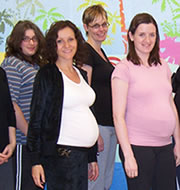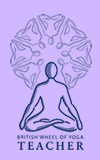|
YOGA & PREGNANCY
ANTENATAL YOGA CLASS teacher with BWY pregnancy module
Yoga has an holistic approach. It is designed to work on the whole person at many different levels, working from the physical body to benefit the systems of the body; nervous, cardiovascular, respiratory, lymphatic, etc. Through the physical we reach the emotional, mental and spiritual. This approach makes it valuable for pregnancy, where the whole system is affected by the various changes that occur before, during and after a woman gives birth.
During the first three months of pregnancy many students feel sick or tired, there are many internal changes happening at this time and this is the body’s way of telling the mother to nuture and nurish the body. Some may feel well and want to carry on with their yoga practice working very gently, particularly in twists, with modified inversions and no jumping. If there is a history of miscarriage or complications, they should wait until after week 14 to carry on with their yoga practice.
 If you have never practiced yoga or have practiced very little before your pregnancy, you should practice only antenatal yoga while pregnant, it is not advisable to attend a normal yoga group in this period. If you already practice yoga tell your teacher as soon as you know that you’re pregnant. He/she should give you individual guidance and modifications to your practice. Some yoga teachers, with a more vigorous style don’t allow pregnant women to attend their classes.
Yoga encourages and maintains good posture, toning the postural muscles and preventing excess lumbar lordosis (over arching of the lower spine). Stretching promotes good circulation and gives suppleness to the hips and pelvic muscles and ligaments.
Yoga teaches control over the respiratory muscles, and allows greater expansion of the thorax. It gives control over the breath at a time when the mind is concentrating and the body is working strongly.
Yoga teaches relaxation techniques, it is helpful in lowering high blood pressure, gives the body time to rest and recover and helps sleep patterns. Pregnancy is a stressful and worrying time for many different reasons, relaxation helps stress relief.
In becoming aware of the body, and consciously relaxing certain areas while others work, and bringing attention to the breath yoga can lessen pain.
The stability of body and breath along with concentration exercises and meditation result in a mind that is less influenced by the emotions. In the changing world of pregnancy, with swings in hormone levels and the physical and emotional changes that happen during pregnancy, birth and post natal life, Yoga has much to offer.
In the second trimester women usually feel very well and Yoga is only restricted by the increasing size of the abdomen. Pregnancy is no time to make great strides in Yoga. Any movements that compress the abdomen should be avoided. This includes lying on the front (prone), on the back (supine), strong forward bends with the legs together and strenuous backbends. Now is not the time to learn inverted postures e.g. headstand, but if already proficient they can be carefully continued for a while. Supported inverted postures help with circulation.
Be careful not to over stretch. During pregnancy the body produces the hormone relaxin, which softens the connective tissue. The good news is that this allows the pelvic joints to become more flexible while the uterus expands, making space for the baby. The bad news is that it can lead to instability in the sacroiliac joints and can cause lower back pain, so pregnant women need to be careful not to overstretch in their asana practice. Pregnancy is not a time to strive for more flexibility, although it may occur. This effect lasts for several months after delivery.
There are many postures that you can perform perfectly up until you give birth! Many alternatives are only a slight variation on the posture, e.g. place feet slightly apart instead of together. If the placenta is attached at the top of the womb (the scan can tell you this) positions with the shoulders lower than the hips may be uncomfortable e.g. down face dog. Do not lie on the back after 16 weeks, if you find anything uncomfortable at all then it is advisable to modify these postures to some other position.
After the birth is a busy time for a new mum, but a progressive return to Yoga and exercise that nourishes rather than depletes the body is essential. Gentle movement with breathing soothes the nerves. Pelvic floor exercises (Mula Bandha) will strengthen this area and abdominal exercises return abdominal tone. Twists with the leg across the body and the eagle balance help to close the hips, and any position with the knees wide should be avoided for at least 3 months after birth or after ending breast feeding. Gentle exercises will strengthen the body ready for a return to normal yoga classes when the baby is about 6 months old. The body will retain relaxin for many months and striving for stretches should still be avoided.
BACK
| |


